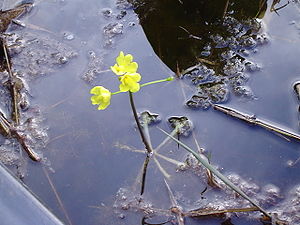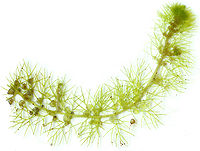Bladderwort
| Bladderwort |
|---|

|
| Scientific Classification |
|
| Species |
|
The bladderwort is a carnivorous plant belonging to the taxonomic genus Utricularia. They are common as either terrestrial or aquatic species with approximately 220 species, and found globally except on Antarctica. Bladderworts can capture insect’s larva, aquatic worms, and other small swimmers, and are named for the bladders on their leaves used to float the plant.[1]
Anatomy
- Weed Description- These are submerged plants that have no roots to hold them down. Most bladderworts can be found in many ponds, lakes and ditches. The majority of bladderworts are aquatic plants but some can be found on the shores of lakes and rivers. [2]
- Leaves- the bladderwort has no true leaves, but the stem is the leaf for the plant. If you remove the bladderwort from the water, it will appear almost clear with a reddish pinkish color.[3]
- Stem- most bladderworts stems are floating or submerged the stem will usually have the worts connected to the end of the stem.[4]
- Flowers- Bladderworts have mostly yellow flowers but sometimes they can have white (Utricularia olivacea) flowers or even purple (Utricularia purpurea). These flowers are 3-4 inches in length and grow on leafless stems up to 6 inches in length. They are always above the water surface. .[5]
- Identifying Characteristics- the bladderworts stems and leaves are big helpers that make it easy to tell the difference between the bladderworts and other weeds in its area.
Reproduction
There are some triggers that will trigger the reproduction of the vegetation of the bladderwort. The bladderworts long thin threads will appear when time to reproduce; they will turn tubular and stay open until the rain falls. With the tubes open they are able to stay alive when water is scarce in their location. The bladderwort uses pollination to reproduce. Insects and other animals take the pollination out of the flower and distribute it to different places.[7]
Ecology
The bladderwort has a plus 200 species, and can find all of them world wide.[8] Bladderworts are carnivorous plants they catch and eat plants that go inside of there bladder pouch, and then once in the pouch the plant breaks the invertebrate down to nitrogen and other nutrients
In the East Coast States you will find the bladderwort most inhabited throughout New York, Massachusetts to Florida. When in the water you can easily point out the plant by its branches holding up the inflorescence. The inflorescence buds are the flowers on top of the stem they can hold up to twenty yellow buds. The Utricularia is another type of or species of the bladderwort it has up to 1-6 flowers. [9] The Bladderwort that has the minute traps is usually the one that floats, it is anchored to the surface so the current doesn’t wash it away out of its habitat the plant will disappear once its living space/ habitat is dried up and most of the water is gone.
Trapping Mechanism
- Physical Description of the Trap
-Broad beans are attached to the bladderworts that are submerged stolons by slender stalks under the water. Very thin and transparent walls make up the bladder with its very flexible inside. The mouth is made up of an oval flap which when closed, is joined by the under flexible flap. The bladders doors are thick and rest on a solid platform. Mucilage on the outside of the trap helps seal the doors when closed with prey inside. The small terrestrial species contain a small trapping mechanism; the aquatic bladderworts have bigger chambers of bladders to hold more air since there under water. The trapping mechanism is branched out from the mouth so false prey can accidentally trigger the suction mechanism.
- Trapping Mechanism
If you take a look at the trapping mechanism of the bladderworts you will see it’s mostly mechanical. The way that the trap is triggered is by the pumping out of the water bladder by active transport. When water is squeezed out it creates a vacuum seal inside of the bladder which traps the prey. This is called “osmotic pressure.”
Trigger hairs exit outward from underneath the trap doors. You can find them in the Dionaea and Aldrovanda. If you look at the suction force that is enforced by the doors of the bladder they lay on the trigger hairs to use there suction. Once you have set off the bladders trigger mechanism it will re-inflate back to its original size. Whatever organism touched the trapping mechanism is automatically sucked into and the doors are shut back on him. This whole cycle takes as long as one- hundredth of a second.
The prey that is sucked into the bladder is automatically coated in digestive secretions. The host will live up to several days inside of the bladder before being fully digested, but the bladder will still pump in and out water.
References
- Bladderworts
- Utricularia - Aquatic Bladderwort
- link title Author. Publisher. Date
- bladderwort This article is © Research Machines plc 2009. All rights reserved. Helicon Publishing is a division of Research Machines plc.
- Common Bladderwort/ Location Dynamic PHP/MySql elements by Shaun MacRae & Ian Bruseker
- Utricularia This page was last modified on 13 April 2009, at 21:59 (UTC).
- bladderwort plant Student Britannica Articles (Ages 11 and up) on "bladderwort (plant)" from the Britannica Online Student Edition


